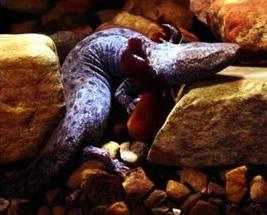 The Leopard Gecko (Eublepharis macularius), a pet trade staple, is sometimes promoted as an easy-to-keep “starter-lizard” that requires little more than heat and some vitamin-powdered crickets. Those who follow this advice may keep their pet alive for a few years, and may even feel satisfied that they have provided it with a good life…similar to the mentality that doomed millions of Red-Eared Sliders to early deaths years ago. However, the Leopard Gecko’s captive lifespan should be measured in decades, not years – animals in their teens are common, and the record-breaker exceeds 30 years of age. Following are some tips to help you provide the best possible diet for your pet. Read More »
The Leopard Gecko (Eublepharis macularius), a pet trade staple, is sometimes promoted as an easy-to-keep “starter-lizard” that requires little more than heat and some vitamin-powdered crickets. Those who follow this advice may keep their pet alive for a few years, and may even feel satisfied that they have provided it with a good life…similar to the mentality that doomed millions of Red-Eared Sliders to early deaths years ago. However, the Leopard Gecko’s captive lifespan should be measured in decades, not years – animals in their teens are common, and the record-breaker exceeds 30 years of age. Following are some tips to help you provide the best possible diet for your pet. Read More »
Monthly Archives: February 2010
Aqua Gloves – an Important Tool in the Fight against Salmonella and Mycobacteria
 Turtles have been much in the news as potential carriers of Salmonella, but many people do not realize that nearly any creature, including dogs and cats, can transmit the bacteria. Less well-known are the potential health problems posed by Micobacteria, many species of which thrive in aquariums housing fishes, amphibians, reptiles and/or invertebrates. Coralife Aqua Gloves are an excellent safety measure for those times when your hands must be submerged in aquarium or aqua-terrarium water. Read More »
Turtles have been much in the news as potential carriers of Salmonella, but many people do not realize that nearly any creature, including dogs and cats, can transmit the bacteria. Less well-known are the potential health problems posed by Micobacteria, many species of which thrive in aquariums housing fishes, amphibians, reptiles and/or invertebrates. Coralife Aqua Gloves are an excellent safety measure for those times when your hands must be submerged in aquarium or aqua-terrarium water. Read More »
The Chuckwalla – a Hardy, Personable Candidate for the Desert Terrarium – Part 2
 Please see Part I of this article for more on the natural history of North America’s second largest lizard, the Chuckwalla (Sauromalus obesus).
Please see Part I of this article for more on the natural history of North America’s second largest lizard, the Chuckwalla (Sauromalus obesus).
Status in the Wild
Population levels appear stable as their preferred habitat is largely unsuitable for development. The species S. varius, however, is limited in distribution to 3 islands in the Gulf of California and is listed on CITES Appendix I. Read More »
The Natural History and Care of Newts – Japanese and Chinese Fire-bellied Newts
Please see The Natural History and Captive Care of Newts, Part I for general information. Today we’ll take a look at newt that has long been popular with amphibian enthusiasts, the Japanese Fire-Bellied Newt (Cynops pyrrhogaster). This species is often confused with the Chinese Fire-Bellied Newt, C. orientalis. Chinese Fire Bellied Newts are smaller, with less-distinct paratoid glands and smoother skin (shown here in the photo of 2 submerged animals). They can be cared for in much the same manner as their Japanese cousin. Read More »
Wild Caught Invertebrates as Reptile and Amphibian Food – Some Concerns
Today I’d like to highlight a question that was recently posed on this blog concerning the use of wild-caught invertebrates as pet food. The writer expressed the well-founded concern that fertilizers might render such invertebrates toxic, and also asked about the possibility of parasite transmission.
Fertilizers
Fertilizers might be a concern for invertebrates collected in high use situations, such as insects seined from farm ponds or earthworms taken from golf courses. Frogs in farm ponds are being affected by fertilizers, but likely directly, through water absorption, rather than via diet. I always play it safe and avoid such areas, and I do not collect insects, such as roaches or Japanese Beetles, that are the focus of pest-control campaigns. Read More »
 That Reptile Blog – Reptile, Amphibian and Exotic Pet Care and Information
That Reptile Blog – Reptile, Amphibian and Exotic Pet Care and Information
